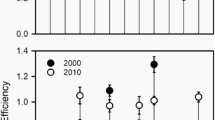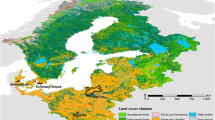Abstract
Since more than 30 years, the Swedish government as well as other governments in the drainage basin strives toward a reduction in nutrient loads to Baltic Sea coastal waters in order to combat eutrophication of the sea. In spite of this, the cost-effectiveness of actual environmental policy for meeting Baltic Sea nutrient targets has not been evaluated by national or international bodies in the region. The aim of this paper is to evaluate Swedish national nitrogen and phosphorus policies with regard to cost-effectiveness. This is done through a comparison of nutrient measures implemented through environmental policy decisions 1995–2005 with cost-effective policies for present national as well as Baltic Sea Action Plan (BSAP) targets. The cost-effective measures are calculated using an empirical programming model including all countries adjacent to the Baltic Sea. Calculations show that measures that jointly reduce nitrogen and phosphorus are hardly applied in actual policy and that reductions in the agricultural sector are much smaller than is cost-effective. Data show, surprisingly, that considerable reductions have been carried out in the Bothnian Sea catchment in spite of there being no nutrient reduction target for this catchment. Results suggest also that the Swedish costs for meeting the new and geographically more restricted targets under the BSAP can be reduced if a policy with less restrictions on the location of phosphorus abatement is applied, compared to what is now suggested.



Similar content being viewed by others
Notes
In contrast to Gren et al. (2008), the model employed here does not account for interdependencies with regard to the impact of different measures on coastal load. This means that in principle, costs are underestimated. However, a comparison with results in Gren (2008) suggests that this is of small importance for the results.
Although convex cost functions for each abatement option would be more realistic, data necessary to construct such functions are in most cases not available. The total cost function is however, increasing at an increasing rate, given the variation in unit costs between measures and regions.
Calculations are based on econometrically estimated demand functions, see Gren et al. (2008). For the cost functions, a constant elasticity of demand is assumed, and the loss in consumer surplus is calculated through integration of the demand curve minus the price.
The emission coefficient has been obtained through division of the cost at the sources by the marginal cost of reductions in nutrient loads to coastal waters. These data are obtained from the Appendix in Gren et al. (2008).
References
BOA (Board of Agriculture) (1999) Ammonia losses to agriculture—proposals for targets and measures [In Swedish]. Report 99:23. Board of Agriculture, Jönköping
BOA (Board of Agriculture) (2004) Three new environmental support schemes—what was the result? Report on CAPs environmental impact [In Swedish]. Report 2004:5. Swedish Board of Agriculture, Jönköping
Boesch D, Hecky R, O’Melia C, Schindler D, Seitzinger S (2006) Eutrophication of Swedish Seas. Final report. Environmental Protection Agency, Stockholm
Brännlund R, Kriström B (2001) Too hot to handle? Benefits and costs of stimulating the use of biofuels in the Swedish heating sector. Resour Energy Econ 23:343–358
Bryhn A, Håkansson L (2009) Coastal eutrophication: whether N and/or P should be abated depends on the dynamic mass balance. PNAS 106: E3 (Letter to the Editor)
Elofsson K (2006) Cost-effective control of interdependent water pollutants. Environ Manag 37:54–68
Elofsson K (2010a) Baltic-wide and Swedish nutrient reduction targets: an evaluation of cost-effective strategies. Expert Group for Environmental Studies, Ministry of Finance, Stockholm
Elofsson K (2010b) Cost-effectiveness of the Baltic Sea Action Plan. Marine Policy 34:1043–1050
Elofsson K, Gren IM (2004) Cost-effectiveness of Swedish environmental policy for the Baltic Sea—an evaluation [In Swedish]. Ekonomisk Debatt 3:57–68
Environmental Objectives Portal (2008) Indicators. As available 28 April 2008 at http://www.miljomal.nu/Pub/IndikatorList.php
EPA (2008) No eutrophication—background report to the detailed evaluation of the environmental policy [In Swedish]. Report 5840. Environmental Protection Agency, Stockholm
Gren IM (2008) Costs and benefits from nutrient reductions to the Baltic Sea. Report 5877. Environmental Protection Agency, Stockholm
Gren IM, Wulff F (2004) Cost-effective nutrient reductions to coupled heterogeneous marine water basins: an application to the Baltic Sea. Reg Environ Change 4(3):159–168
Gren IM, Elofsson K, Jannke P (1997) Cost-effective nutrient reductions to the Baltic Sea. Environ Resour Econ 10:341–362
Gren IM, Jonzon Y, Lindqvist M (2008) Costs of nutrient reductions to the Baltic Sea—technical report. Workingpaper 2008:1. Department of Economics, Swedish University of Agricultural Sciences, Uppsala
HELCOM (2007a) HELCOM Baltic Sea Action Plan. HELCOM Ministerial Meeting, Krakow, Poland, 15 November 2007. HELCOM, Helsinki
HELCOM (2007b) Outcomes from the expert meetings of the HELCOM Baltic Sea Action Plan, 2.1 eutrophication segment. An approach to set country-wise nutrient reduction allocations to reach good ecological status of the Baltic Sea. HELCOM HOD 22/2007. HELCOM, Helsinki
HELCOM (2008) Pathways and sources of nutrient inputs. Available from http://www.helcom.fi/environment2/eutrophication/en_GB/inputs/ Accessed 20 August 2008
Johansson M (2007) Incentives and outcomes: evaluation of a Swedish environmental subsidy programme. J Environ Plan Manag 50(3):343–362
Lääne A, Pitkänen H, Arheimer B, Behrendt H, Jarosinski W, Lucane S, Pachel K, Räike A, Shekhovtsov A, Svendsen LM, Valatka S (2002) Evaluation of the implementation of the 1988 ministerial declaration regarding nutrient load reductions in the Baltic Sea catchment area. The Finnish Environment 524. The Finnish Environment Institute, Helsinki
LRF (The Federation of Swedish Farmers) (2008) Eco-tour of the house [In Swedish]. The federation of Swedish farmers. Available from http://www.lrf.se/viarbetarmed/miljo/miljohusesyn. Accessed 21 April 2008
MOF (Ministry of Finance) (2009) Budget bill for 2010. Bill 2009/10:1. Ministry of Finance, Stockholm
Savchuk O (2005) Resolving the Baltic Sea into seven subbasins: N and P budgets for 1991–1999. J Mar Syst 56(1–2):1–15
Wulff F, Savchuk O, Sokolov A, Humborg C, Mörth CM (2007) Management options and effects on a marine ecosystem: assessing the future of the Baltic. Ambio 36(2–3):243–249
Acknowledgments
I wish to thank Björn Carlén, Fredrik Wulff, Runar Brännlund, Henrik Scharin, Per Stålnacke, two anonymous reviewers and the editors for valuable comments on this paper; any remaining errors are my own.
Author information
Authors and Affiliations
Corresponding author
Rights and permissions
About this article
Cite this article
Elofsson, K. Swedish nutrient reduction policies: an evaluation of cost-effectiveness. Reg Environ Change 12, 225–235 (2012). https://doi.org/10.1007/s10113-011-0251-8
Received:
Accepted:
Published:
Issue Date:
DOI: https://doi.org/10.1007/s10113-011-0251-8




